Butcher it Yourself: Delicious Filets From a Tenderloin
We all love a good steak dinner, especially for special occasions like anniversaries, graduations, or Valentine’s day, but a steak dinner out—at least, at any steakhouse with quality meat and cooks who don’t overcook your food—can be a steep proposition, financially speaking. Instead of spending all that cash on a couple steak dinners that, let’s be real, might not even be that great, you should butcher your own filets at home and cook your steaks exactly how you like them.
In this post, we’ll go over this simple butchery task so that you can have truly amazing steak dinners at a fraction of the price, but from a better restaurant—your kitchen!
The cost of steak: what you’re paying for
If you go out for a steak dinner, you’re paying for the meat, the trim heat they take off the meat, the restaurant staff, the restaurant’s rent, and the company’s profit. That piles up. And since most steakhouses are only ok (especially certain large chains that we won’t name), you’re paying all that for a mediocre steak.
By buying a whole beef tenderloin and butchering steaks out of it yourself, all you pay for is the steak and the trim, a lot of which you can use in other applications. For this post, we bought a whole tenderloin (more on that below) for about $130 and cut 11 7–8 oz steaks out of it. That comes to just under $12/steak! 1 And by using your Thermapen® ONE to cook it, you can be sure you get it just the way you like it, not the way some new-guy grill cook sends it out to you. Yes, the initial cost is kind of high, but the cost washes out very quickly.
Convinced? We hope so. Let’s learn about how to do it.
Getting the Most out of Your Beef Tenderloin: What to Buy
First, you need to get a whole tenderloin. It’ll cost more, but a tenderloin that is Choice or higher makes for a better experience. We usually buy Choice. Now, that said, this is a lean cut anyhow, so Select won’t be bad!
When you approach your butcher, you can ask for a whole tenderloin, but they might try to sell you a pre-trimmed loin. If you buy that, you’re paying for their waste, the trim, but not getting it. Instead, ask for a PSMO (pronounced Piz-moh).
‘PSMO’ stands for Peeled, Side Muscle On. This is what your butcher buys to cut steaks out of, and any well-supplied butcher counter should have some (though it never hurts to call ahead, depending on the season). It’s a vacuum-packed whole loin with all the silver skin, some fat and membranes, the chain-muscle, and the head muscle still on. And it’s wonderful.
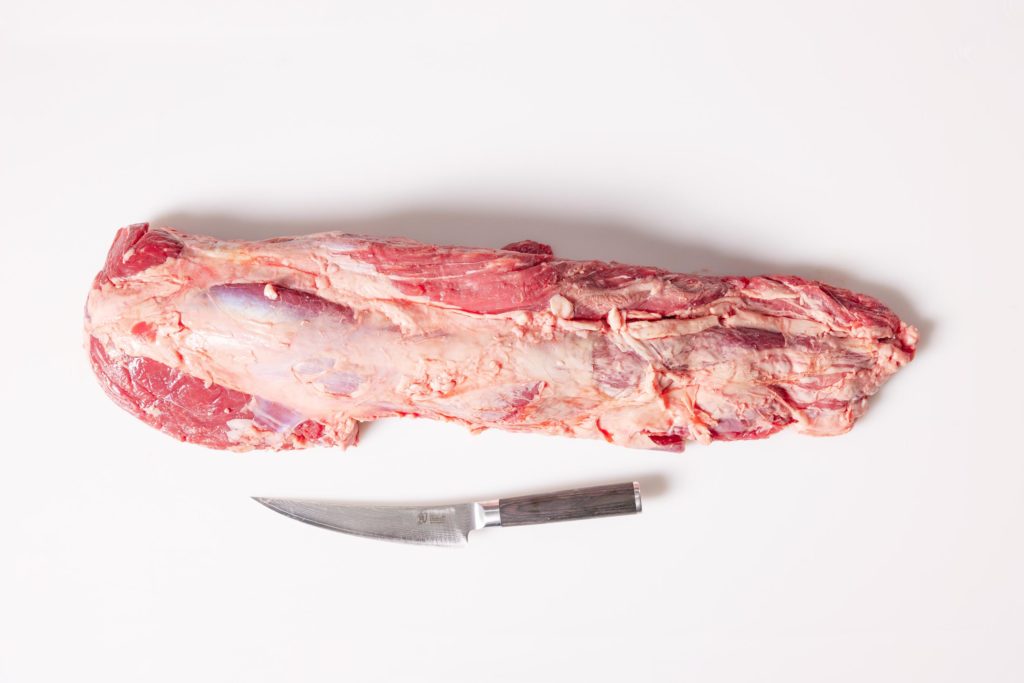
Some large discount club stores also sell something they call “super peeled” or “super trimmed” or something. Those are great if you want to pay a little more per steak—again, you’re paying the per-pound price for the trim that came off. Go with a PSMO.
Clean and Trim Your Beef Tenderloin
Once you’ve got your meat home it will take a little bit of time to prep the loin before it’s ready to cut and portion.
- First, remove that side muscle—the “chain”. Grab it and pull it off! Then use a sharp boning knife to cut it free along its natural seam. Save the chain.
- Now flip the loin over and cut off the weird flappy-ribby bits. Those are fine for other applications but are a little tough for a filet steak. Save the bits!
- Cut the silver skin off the whole thing, and any fatty pieces, by sliding your knife along just below its surface. Don’t save the silverskin.
- Cut the head muscle off by cutting along its natural seam against the loin. Remove the silver skin from both pieces.
That’s all you need to do to clean up the loin for cutting! It may not go perfectly the first time you try, but it doesn’t take long to get it right.
Note that some people leave the head on and cut extra wide steaks from this part of the loin, but those steaks will have a little inedible silverskin in them, and as these are supposed to be luxurious, opulent steaks, we don’t do it that way.
Now you have a loin, a head, and some trim. You can use the chain and trim (remove any large silver skin portions) for beef Stroganoff, stew, tacos, or even grinding into burger. But what about the good bits?!?
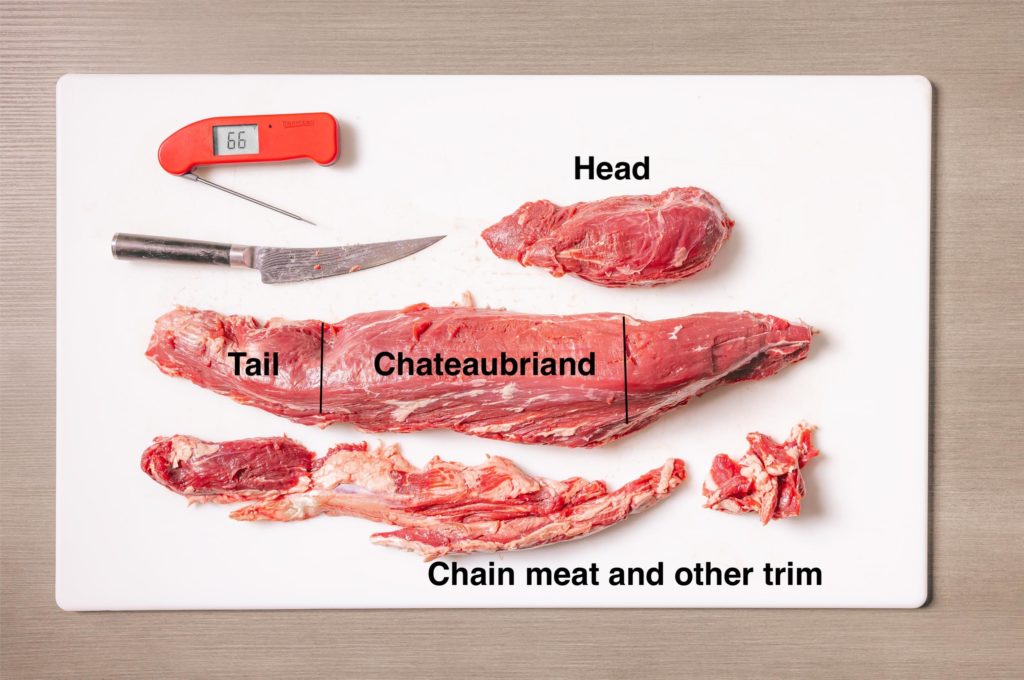
How to Butcher Beef Tenderloin Into Filets
With the loin trimmed, cleaned, and ready to cut, you get to decide how to proceed. You can cut out a portion of the tenderloin and use it for a roast or even a beef Wellington (using the head muscle for a mini Wellington is a great idea). Heck, you can tie the tail down and roast the whole thing! But we came here for steaks, and steaks is what we’re going to talk about.
Cut a chunk off about four inches from the end of the loin where the head used to be. Cut that piece almost all the way through, in half. Fold it in half on that cut joint and tie it with some twine—that’s your first steak! Now cut the loin with confident, sure cuts every 1 1/2–2 inches. You can trim each steak as you see the need.
When you get about four inches from the end of the tail, do the same maneuver you did with the head piece, making a tied steak. Cut a small piece from each end of the head, if you aren’t using it for a mini-roast, and cut it in half for two more steaks.
Depending on the size of the loin and the size of steaks you’ve cut, you will have 8–11 amazing filet mignon steaks!
Saving for Later Use
Now, although it would be fun, you don’t have to eat all of these steaks at once. They freeze, vacuum packed, beautifully. If you’re not freezing them all, make sure you’re storing the ones you intend to eat soon (within 3-5 days) below 37°F. And remember that it’s always a good idea to label your wrapped meat with a time and date stamp to help you remember when they were prepped and stored.
Cooking Filet Mignon Steaks
We have written plenty about cooking steaks. You can smoke them, grill them, or sear them. We love to sear them, often using the reverse sear technique.
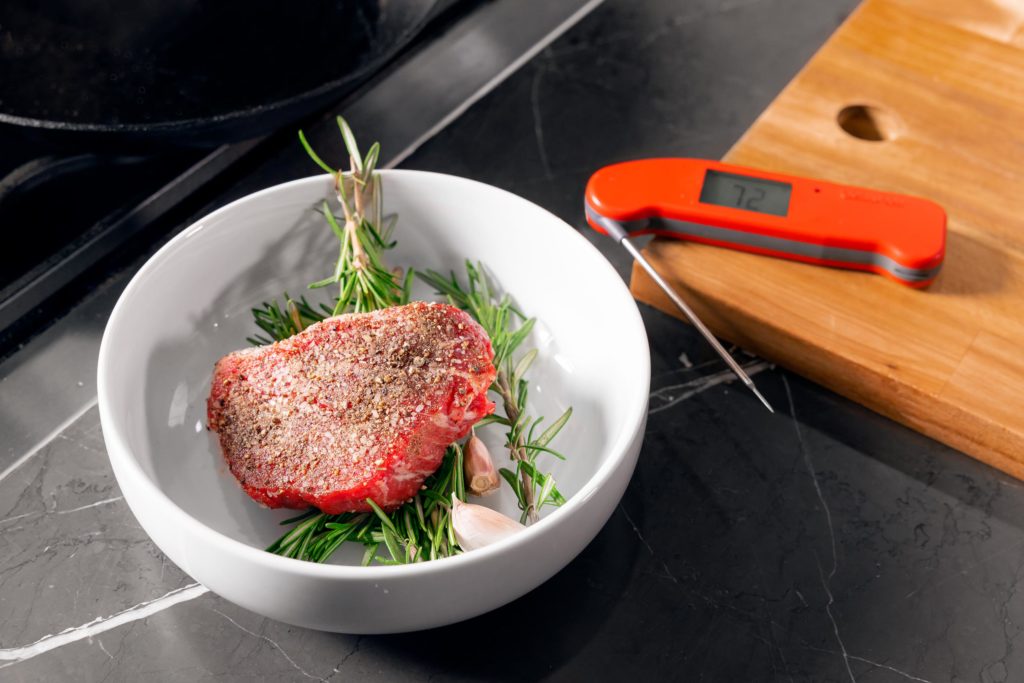
But we also love the “just keep flipping” technique, as Jess Pryles calls it. Season your steaks well and let them rest for 5–10 minutes. Heat your heavy pan to at least 425°F (218°C), add about a tablespoon of high-heat oil, and put the steak in the pan. Then flip the steak every 45 seconds (we use an Extra Big & Loud timer).
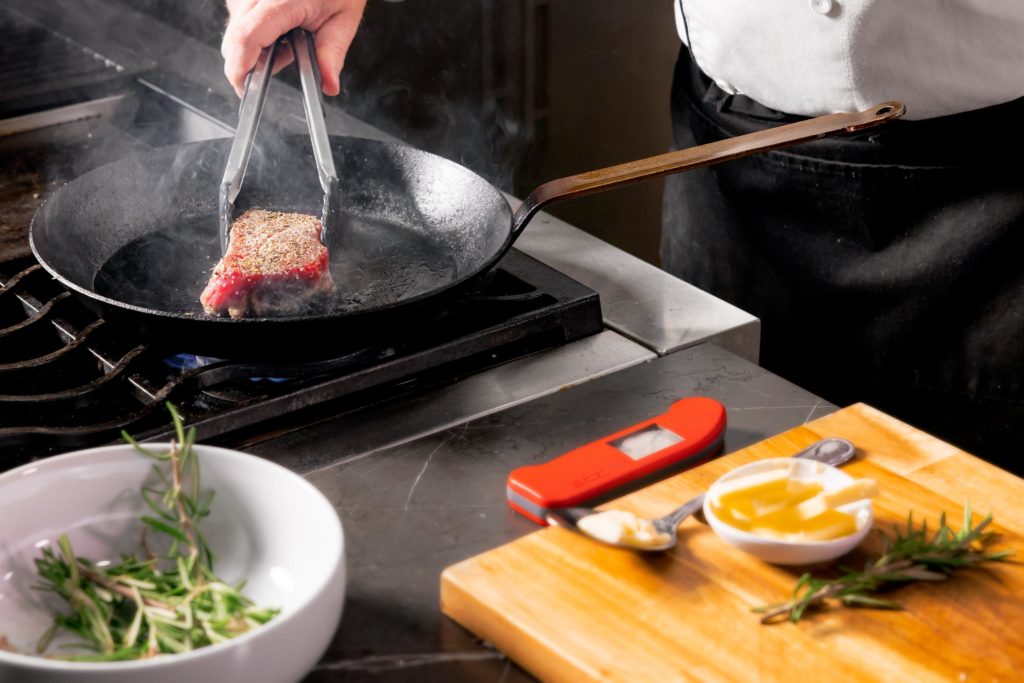
After four or five flips, you should be at about 95–100°F (38–38°C). Add 3–4 Tbsp butter, a clove of crushed garlic, and some rosemary or thyme to the pan, tilt the pan towards yourself and use a spoon to baste the steak with the hot butter. Do this for about 30–45 seconds, then flip the steak and temp it. If it has reached 115–120°F (46–49°C) (for medium rare), remove the steak from heat.
Carryover Cooking
In a very high-heat application like this, the carryover will be 10–15°F (6–8°C), so it’s important to use a fast and accurate thermometer like Thermapen ONE to check the temperatures of the steak as it’s cooking.
Resting
After browning, cover the meat with foil and let the steak rest for 5 minutes. The carryover will occur during the rest, but so will some relaxation of the muscle fibers. The highest temperature reached should be about 130°F–135°F (57-63°C) for medium rare steak.
Conclusion
There are plenty of reasons to eat out—dishes you might never attempt at home that are worth paying for. But a tenderloin steak—you can cook that yourself! Save money, learn a new skill, and have the best steak dinner of your life, whether for a holiday or just because you feel like a good steak tonight. We hope you give this a try and enjoy a freshly butchered, perfectly cooked filet thanks to your new knowledge and your Thermapen ONE. Happy cooking!
Shop now for products used in this post:
If you know where to get an excellent filet dinner for that cost, tell us where!↩


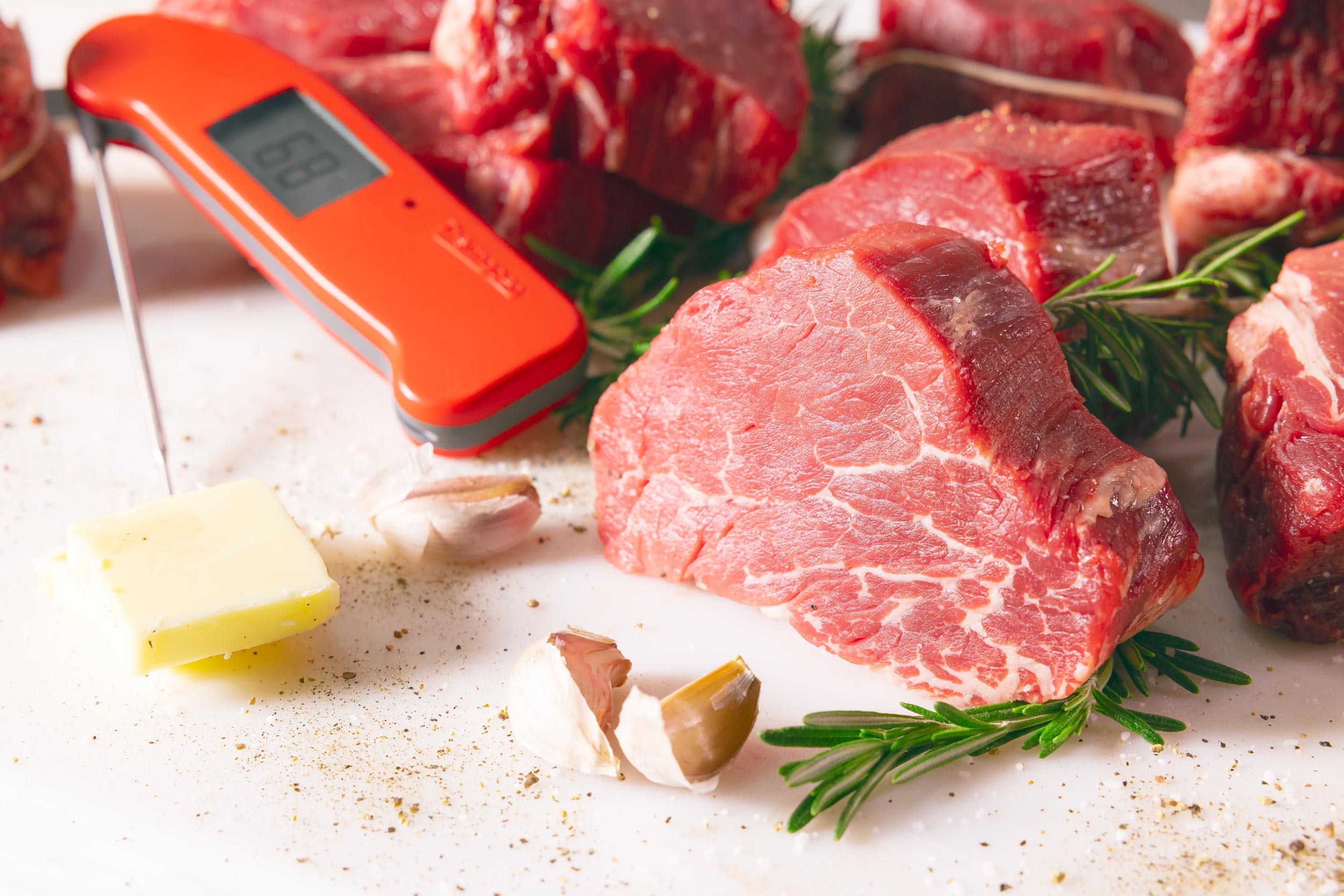

I LOVE my Thermapen products that I have purchased. Your fast delivery and great products will keep me envolved forever. Thank you!!!
very good, informative and timely tutorial
Thanks
Thanks for the thorough but concise information on preparing a PMSO tenderloin roast from the cryopac to the table. I have used a similar procedure for standing rib roasts – low temperature for maximum tenderness and juiciness. I can’t wait to try it. Tenderloin is getting so expensive in the case, but the club stores provide the raw material at a more affordable price.
I tried this recipe on Christmas day. Cooked it on my Weber gas bbq. It came out fantastic with the help of my Thermapen. My Thermapen took much of the stress out of making sure we had the proper doneness for all taste. Whew!
very informative however where do you get your base tenderloin?
We got ours at a very large box-shaped discount club store. It was Costco. We got it at Costco.
An excellent and easy to follow presentation to maximize the use of a beautiful cut of SNF goodness. Thanks.
I’ve noticed a lot of cooking sites, this one included, mention all sorts of methods of cooking steaks (reverse sear, etc.), but rarely or never sous vide. The one time investment in equipment is low, and cooking steaks using sous vide is foolproof.
We love a sous vide steak! we should put one of those up sometime.